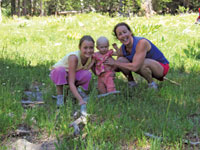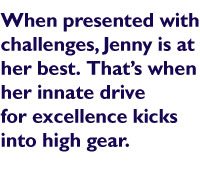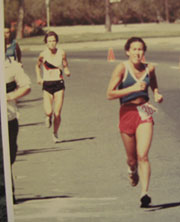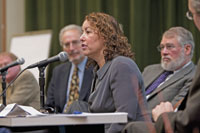 Hard-driving. Determined. Persistent. An accurate description of Title Nine customer Jenny Chatman, but far from complete. Fun-loving. Family-oriented. Outdoorsy. Energetic. These are all qualities that Jenny zestfully exudes, and they have served her well in pursuing her goals as a professor, consultant, wife, mother, and athlete. But if you had to choose just one word to describe Jenny, you just might settle on extraordinary. From giving birth at age 48 to running the Olympic torch across the Golden Gate Bridge, there is nothing ordinary about Jenny’s life—not even her daily routine. In fact, the only thing routine about Jenny’s day is that she works out.
Hard-driving. Determined. Persistent. An accurate description of Title Nine customer Jenny Chatman, but far from complete. Fun-loving. Family-oriented. Outdoorsy. Energetic. These are all qualities that Jenny zestfully exudes, and they have served her well in pursuing her goals as a professor, consultant, wife, mother, and athlete. But if you had to choose just one word to describe Jenny, you just might settle on extraordinary. From giving birth at age 48 to running the Olympic torch across the Golden Gate Bridge, there is nothing ordinary about Jenny’s life—not even her daily routine. In fact, the only thing routine about Jenny’s day is that she works out.
A professor at Haas School of Business, nationwide business consultant, member of several boards and committees, and mother of two young girls—Ava (ten) and Sonya (one)—Jenny’s schedule varies widely from season to season, month to month, and even day to day. Some mornings she is up and out the door early for a consulting meeting in San Francisco or to catch a flight east to present a research paper. Other days she sleeps in after a late night of writing at the computer.
The rest of Jenny’s day is characterized by equally immense variety, which is just the way Jenny likes it. With variety comes challenges. And when presented with challenges, Jenny is at her best. That’s when her innate drive for excellence kicks into high gear.
The Making of an Elite Athlete
Sometimes responding to one challenge begets another. Take the birth of Jenny’s running career, for example. Not much of an athlete in high school, Jenny picked up running her first year of college at UC San Diego. Why? To combat a bout of insomnia brought on by a case of academic perfectionism. She started running around the quad to expend pent up energy. At first, she could barely make it, but soon her circle was expanding. Then she transferred to UC Berkeley and started running around the track—bit by bit, a little faster, a little farther. She never timed herself, so initially she had no idea how fast she was. “I knew that I didn’t like people to pass me,” she says. “So I ran fast enough that they didn’t.”
Soon some friends talked Jenny into running the Bridge to Bridge race in San Francisco, which boasted a field of about 1000 runners. Jenny placed fifth among all women. That’s when she started getting serious about her running. Serious enough that she chose to attend graduate school in Boulder in large part to train with a club run by legendary long distance runner Frank Shorter. That marked the beginning of a competitive racing  career that saw Jenny consistently placing in the top three women overall and usually winning her age category. Her fastest 10K? About 33 minutes, at altitude in the mountains. Her fastest marathon? Just a hair under three hours. Nothing ordinary about that.
career that saw Jenny consistently placing in the top three women overall and usually winning her age category. Her fastest 10K? About 33 minutes, at altitude in the mountains. Her fastest marathon? Just a hair under three hours. Nothing ordinary about that.
But Jenny’s days as a competitive runner came to an abrupt end when she tore her Achilles tendon due to overuse. Suddenly unable to run, the injury marked a pivotal moment in Jenny’s fitness career. “It led me to realize that I loved this—running, and the feeling that it gave me—so much that I wanted to figure out how I could do it for the long run,” Jenny says. “In the stock market they say broaden your portfolio. That was exactly the metaphor for what I did. I got good at swimming. I got good at biking. And not just good at them. I figured out how to make them comfortable and fun for me.”
Fitting in Fitness
Now 49 years old and just over a year past giving birth to her second child, Jenny is back running full steam—if not quite full speed—but she also cross-trains and rarely races anymore. In the summertime, which she spends with her family in Tahoe, Jenny does a 60 to 75-minute trail run with her dogs everyday, along with a more than refreshing swim in frigid Lake Tahoe. Some days, she substitutes a 2-plus-hour mountain bike ride for her run, or occasionally she’ll do a road bike ride instead.
During the school year in Berkeley, Jenny runs for 50 to 60 minutes every other day. On days she doesn’t run, she goes to the gym and works out using the Bosu, medicine ball, pullies, and other equipment. Then she does about a mile of lap swimming. On the weekends and some weekday mornings, Jenny goes for a 1 to 2-hour mountain bike ride with a friend.
How does Jenny fit all this physical activity into her busy day? It isn’t easy, but she makes working out a top priority. In fact, she rarely takes a day off. “It just doesn’t feel good to me,” Jenny says. She’s been known to change meeting times with colleagues or clients in order to squeeze in a run or gym workout. But the main reason Jenny is able to jam so much into a typical workday is her substantial network of support, which includes her husband Russell, a part-time building contractor and a highly involved dad to their two girls, and a rotation of three part-time nannies, all graduate students at various universities. It also doesn’t hurt that Jenny is the master of her own schedule, which tends to be quite flexible. Even still, fitting in a workout often means getting up early after a late night of traveling to run before a morning meeting or working at the computer for a few hours after the girls go to bed to accommodate an afternoon bike ride. If all this sounds tiring to you, you’re not alone. “Sometimes I say to myself, ‘God, you exhaust me,’” Jenny laughs. “Sometimes I wish I were less ambitious.”
Fit for Life
Jenny’s aggressive fitness regimen has paid dividends not just on the running trails, but also in the classroom and on the homefront. She credits competitive running with teaching her to “work hard and stay focused” and giving her the confidence required to succeed in the competitive world of academia, where choice faculty slots are in short supply. On a more practical level, her physical fitness gives her the stamina to stand for hours in front of a classroom full of super-smart MBA students and the energy to intellectually  challenge them. Competitive running also developed Jenny’s endurance and taught her a bit about how to pace herself. “That endurance has served me well as a 49-year-old mother of a toddler,” she says.
challenge them. Competitive running also developed Jenny’s endurance and taught her a bit about how to pace herself. “That endurance has served me well as a 49-year-old mother of a toddler,” she says.
Not surprisingly, it’s important to Jenny that her daughters value and pursue fitness as well, and she works hard to make that happen. “My challenge has been to figure out how to make sports really joyful for them—not like it’s a big challenge.” So far it seems Jenny is succeeding. Afraid to put her head under water until age 7, Jenny’s 10-year-old daughter Ava now regularly accompanies her mother to the pool and swims 30 laps. Now that’s extraordinary. You go girl!
What has your athletic experience contributed to other areas of your life?

Jenny-
you show us what the steady determination can do. Thanks for that over the 35 years of our friendship. Nice story, and tribute to some of the many things that you have worked towards in your life. I’m inspired to go for a run!
And don’t forget caring sister and daughter. Jennifer has always achieved at extraordinary levels, nice to see it on (virtual) paper. Bravo!
Amazing athelete, amazing professional, amazing mother and an amazing friend. Inspires us all.
re: timeout poll…favorite Olympic event.
hey! don’t forget whitewater kayaking!
(it’s under canoe/kayak…but doesn’t fall under the category “rowing”)
I don’t think it’s appropriate to refer to one’s nannies as part of a “stable” – like livestock, even if they are graduate students.
Actually, I was thinking “stable” like thoroughbreds, but perhaps it wasn’t the best word choice. I certainly didn’t intend any slight toward Jenny’s nannies because they are graduate students. What’s wrong with being a graduate student, anyway? I’d love to go to graduate school myself someday.
But enough about me. I changed the reference from “a stable of three nannies” to “a rotation of three part-time nannies” in order to avoid any potential offense and to clarify that Jenny’s nannies all work part-time and not at the same time. I hope this eases any concerns.
As always, thanks for reading the article and sharing your thoughts.
-Amy
The author
I can’t even afford one nanny. Or a housekeeper, either, for that matter! It’s all me. And I do work outside the home. *sigh* Maybe I am in the wrong field.
I also consider myself an endurance athlete. I enjoy and perform better in longer activities, whether running, biking, or triathlon races–or elsewhere in my life. At 30 yrs old I am just learning to plan ahead in terms of finances and vacations, not to mention my career. I carry the happy feelings of enjoying the race rather than racing to finish (like I used to do in shorter events). I have slowed my career pace, opting to remain in my current position rather than pursue ones with higher pay but much greater demands. This leaves me with more “home” time to spend playing outside (training) and racing. The more I race, the more I am aware of the correlations to my life. Getting into sports as a young girl, I had no idea the affect they would have on my life!!
thanks so much for this woman’s story and the venue to share my own 🙂
wow. i’m impressed and inspired by having a child at 48.
I also know another academic working mom with 4 kids and has 2 nannies and housekeeper — they work in shifts…it’s a small business really..replacing the village — you can do it all, but who said you have to do it alone? works if you can afford it.
THREE nannies???
That’s how she can workout like this. With my 2 kids I am lucky to get more than 60 minutes a day in.
Hi Hillary,
Yes, 3 nannies but never all at once! Each is a graduate student so they can only fit in a few hours a week with us. I wanted to hire people who were like me when I was young (in school and working). We cobble together about 30 hours a week between the three wonderful nannies and feel very lucky that they can spend some time with us!
Jenny
What about softball as an olympic event?